| Article ID | Journal | Published Year | Pages | File Type |
|---|---|---|---|---|
| 4676585 | Cold Regions Science and Technology | 2007 | 12 Pages |
In the Columbia Mountains of western Canada, some snow avalanche forecasting programs use slab stability indices calculated from study plot measurements near tree-line and find these indices helpful for forecasting dry slab avalanching many kilometers from the study plot. Research in the same mountain range has confirmed the correlation between the indices and avalanche occurrence. Due to spatial variability and scale issues, the explanation for the correlation between the indices, which are based on measurements over a small area, and avalanching many kilometers away has been unclear. The stability indices for natural (spontaneous) avalanches are ratios of shear strength of a weak snowpack layer to the shear stress on the weak layer applied by the overlying slab. The denominator of these ratios is proportional to vertical overburden pressure (load). One time series of overburden and shear strength measurements shows that neither measurement can be extrapolated from one site to another. A second time series shows a substantial difference in the stability index between the two sites, which is likely due to different initial crystal sizes in the weak layer at the two sites. However, different sites exhibit concurrent decreases in the strength–load ratio during snowfall and concurrent increases in the ratio after snowfall. The increases after snowfall are explained by lagged densification of weak layers and pressure sintering between grains. Critical values of stability indices are shown to be less useful than their trends for forecasting natural dry slab avalanches. The potential correlation of study plot stability indices with avalanching in surrounding terrain is also limited by the spatial extent of the weather system that forms the weak snowpack layer.
